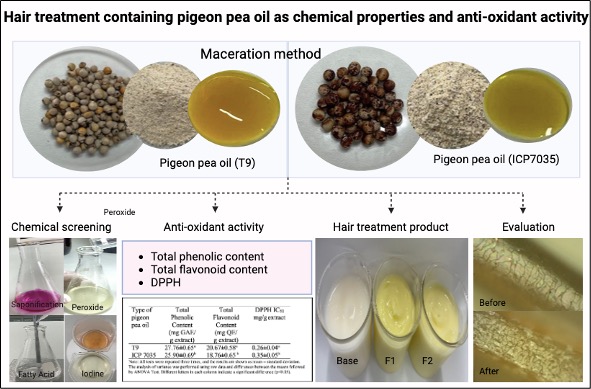Hair treatment products containing pigeon pea oil as chemical properties and anti-oxidant activity
DOI:
https://doi.org/10.55674/cs.v16i3.256828Keywords:
Pigeon pea oil, Chemical properties, Anti-oxidant, Hair care productsAbstract
The comparing small type (T9) and big type (ICP 7035), which were extracted by hexane maceration, this study looks at the properties of pigeon pea oil in hair treatment products. It finds that the percentage yield of big seed (ICP 7035) oil is higher than that of small seed (T9) oil, at 9.64 ± 0.10 and 9.32 ± 0.08, respectively. A study on the chemical properties of the oil revealed values for saponification, acidity, iodine, and peroxide. In all trials, T9 outperformed ICP 7035 in terms of test results, demonstrating the presence of fatty acids in the molecular components of triglycerides. Compared to ICP 7035, T9 had a lower molecule weight and a lower saturation level, making it less susceptible to oxidative lipid disorder and the tendency to deplete oil. The flavonoid content of T9 is higher than that of ICP 7035, equal to 27.76 ± 0.65 mg GAE g-1 extract and 25.90 ± 0.69 mg GAE g-1 extract, respectively. The flavonoid content of T9 is higher than that of ICP 7035, equal to 20.67 ± 0.58 mg QE g-1 extract and 18.76 ± 0.65 mg QE g-1 extract, respectively. The DPPH test showed that T9 was a stronger antioxidant than ICP 7035, with amounts of 0.26 ± 0.04 mg g-1 of extract and 0.35 ± 0.05 mg g-1, respectively. The development of hair care products revealed that a mixture containing the optimal dosage of T9 effectively ensured smooth hair lines and prevented microorganism contamination in all recipes.
GRAPHICAL ABSTRACT

HIGHLIGHTS
-
Pigeon Pea Oil in Hair Care Products
- Comparison of T9 and ICP 7035 oil properties.
- ICP 7035 yield was higher than T9 yield.
- Chemical properties of oil included saponification, acidity, iodine, and peroxide.
- T9 oil had better phenolics, flavonoids, and DPPH values than ICP 7035.
- T9-rich mixtures in hair care products ensure smooth hair lines and prevent microorganism contamination.
References
L.S. Kristiani, F. M. Rajendra, S. Ariviani Antioxidant capacity of pigeon pea (Cajanus cajan L.) sprouts elicited using NaCl with various elicitation time, Mater. Sci. Eng. 56 (2019) 1 – 6.
Y.S. Lai,W.H. Hsu, J.J. Huang,S.C. Wu, Antioxidant and anti-inflammatory effects of pigeon pea (Cajanus cajan L.) extracts on hydrogen peroxide- and lipopolysaccharide-treated RAW264.7 macrophages, Food Funct. 3 (2012) 1294 – 1301.
K.B. Saxena, Genetic improvement of pigeon pea – A review, Trop. Plant. Biol. 1 (2008) 159 – 178.
K.B. Saxena, N, Nadarajan Prospects of pigeon pea hybrids in Indian agriculture. Electron, J. Plant. Breed. 1 (2010) 1107 – 1117.
B. Abebe, The Dietary Use of Pigeon Pea for Human and Animal Diets, Sci. World 2022 (2022) 1 – 12.
G. K. Rakesh, Pharmacology and Phyto- chemicals activities of Cajanus cajan : Review, Emerg. Technol. Innov. Res. 8 (2021) 307 – 319.
D. Tungmunnithum, C. Hano, Cosmetic potential of Cajanus cajan (L.) : botanical data, traditional uses, phytochemistry and biological activities, Cosmetics. 7 (2020) 1 – 12.
P. Watoo, P. Waraporn, T. Hiroyuki, J. Kanchalee, W. Sakchai, I. Kornkanok, Comparison of various extraction methods of bacopa monnieri, NU. J. 15 (2007) 29 – 34.
K. Nattapong, L. Thunnop, Effects of spray- drying temperatures on powder properties and antioxidant activities of Encapsulated anthocyanins from black glutinous rice bran, Nat. Life. Sci. Commun. 23 (2023) 1 – 19.
A.O.C.S., Official methods and recommended practices of the american oil chemists society, Am. Oil Chem. Soc. (1993) 3489 – 61826.
V.L. Singleton, R. Orthofer, R.M. Lamuela Raventós, Analysis of total phenols and other oxidation substrates and antioxidants by means of folin-ciocalteu reagent, Method Enzymol J. 299 (1999) 152 – 178.
Z. Jia, M. Tang, J. Wu, The determination of flavonoid contents in mulberry and their scavenging effects on superoxide radicals, Food Chem. J. 64 (1999) 555 – 559.
W. Brand-Williams, M.E. Cuvelier, C. Berset, Use of a free radical method to evaluate antioxidant activity, Food Sci. Technol. J. 28 (1995) 25 – 30.
M.E. Allen, R.A. Gyure, An undergraduate laboratory activity demonstrating bacteriophage specificity, Microbiol. Biol. Educ. 14 (2013) 84 – 92.
A. Ben David, C.E. Davidson, Estimation method for serial dilution experiments, Microbiol. Methods. 107 (2014) 214 – 221.
K. Kalay, S.C. Moses, K. Ashok, K. Devesh, U. Abhishek, Physical properties of pigeon pea grains at different moisture content, Int. J. Pure App. Biosci. 5 (2017) 556 – 562.
S.O. Aruna, Chemical composition analysis of palm oils in ijebu-ode, ogun state, Afr. J. Chem. Educ. 13 (2023) 91 – 111.
J. Flieger,W. Flieger,J. Baj, R. Maciejewski, Antioxidants: classification, natural sources, activity/capacity measurements and usefulness for the synthesis of nanoparticles, Materials. 14 (2021) 1 – 54.
A.S. Gerrano, A. Moalafi, H.A. Seepe, S. Amoo, H. Shimelis, Nutritional and phytochemical compositions and their interrelationship in succulent pods of pigeon pea (Cajanus cajan L.), Heliyon. 8 (2022) 1 – 7.
R. Adilson, P. Locali, B. Adeline, B.C. Claire, R.T. Sebastião, S.J. Véronique, R.N. Vânia, Pigeon pea, An emerging source of plant-based proteins, ACS Food Sci. Technol. 3 (2023) 1777 – 1799.
N. Wu, K. Fu,Y.J. Fu,Y.G. Zu,F.R. Chang, Y.H. Chen, X.L. Liu, Y. Kong, W. Liu, C.B. Gu, Antioxidant activities of extracts and main components of pigeon pea Cajanus cajan (L.) leaves, Molecules. 14 (2009) 1032 – 1043.

Downloads
Published
How to Cite
Issue
Section
Categories
License
Copyright (c) 2024 Creative Science

This work is licensed under a Creative Commons Attribution-NonCommercial-NoDerivatives 4.0 International License.








